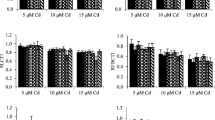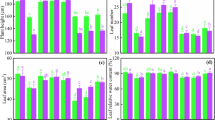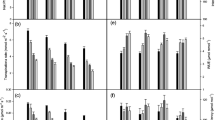Abstract
Increasing soil contamination by heavy metals is a major threat to environmental safety and global food security. The present study examined the influence of Cd and As stresses on morpho-physiological growth and yield of two contrasting maize cultivars (Run Nong 35 and Dong Dan 80). The Cd (100 μM) and As (200 μM) were applied individually as well as in combination (Cd + As) at 30 DAS. A control without Cd or As stress was also maintained for comparison. Application of Cd and As alone or in combination substantially reduced the growth (plant height, number of leaves per plant, leaf area, stem diameter, and shoot fresh and dry weight) and yield (number of ears per plant, number of kernels per ear, and 100-kernel weight) contributing traits in both maize cultivars particularly in Run Nong 35. Furthermore, pronounced reductions in gas exchange attributes (photosynthesis, stomatal conductance, transpiration rate, and intercellular CO2) and chlorophyll contents were observed in metal-stressed plants. The combined application of Cd and As was more detrimental for maize, and this treatment recorded the maximum reductions in morpho-physiological growth and yield of both cultivars. Cultivar variations were also apparent, and Dong Dan 80 performed better than Run Nong 35 for all the studied attributes. The higher tolerance of Dong Dan 80 was associated with better leaf gas exchange and maintenance of chlorophyll contents in this cultivar under Cd and As stress.




Similar content being viewed by others
References
Ahsan, N., Lee, D. G., Kim, K. H., Alam, I., Lee, S. H., Lee, K. W., Lee, H., & Lee, B. H. (2010). Analysis of arsenic stress-induced differentially expressed proteins in rice leaves by two dimensional gel electrophoresis coupled with mass spectrometry. Chemosphere, 78, 224–231.
Aina, R., Labra, M., Fumagalli, P., Vannini, C., Marsoni, M., Cucchi, U., Bracale, M., Sgorbatia, S., & Citterio, S. (2007). Thiol-peptide level and proteomic changes in response to cadmium toxicity in Oryza sativa L. roots. Environmental and Experimental Botany, 59, 381–392.
Andosch, A., Affenzeller, M. J., Lütz, C., & Lütz-Meindl, U. (2012). A freshwater green alga under cadmium stress: ameliorating calcium effects on ultrastructure and photosynthesis in the unicellular model Micrasterias. Journal of Plant Physiology, 169, 1489–1500.
Anjum, S. A., Tanveer, M., Hussain, S., Bao, M., Wang, L. C., Khan, I., Ullah, E., Tung, S. A., Samad, R. A., & Shahzad, B. (2015). Cadmium toxicity in Maize (Zea mays L.): consequences on antioxidative systems, reactive oxygen species and cadmium accumulation. Environmental Science and Pollution Research, 22(21), 17022–17030. doi:10.1007/s11356-015-4882-z.
Anjum, S. A., Ashraf, U., Khan, I., Tanveer, M., Saleem, M. F., & Wang, L. (2016a). Aluminum and chromium toxicity in maize: implications for agronomic attributes, net photosynthesis, physio-biochemical oscillations, and metal accumulation in different plant parts. Water, Air, and Soil Pollution, 227, 326. doi:10.1007/s11270-016-3013-x.
Anjum, S. A., Ashtraf, U., Khan, I., Tanveer, M., Ali, M., Hussain, I., & Wang, L. (2016b). Chromium and aluminum phytotoxicity in maize: morpho-physiological responses and metal uptake. Clean: Soil, Air, Water, 44, 1–10.
Anjum, S. A., Tanveer, M., Hussain, S., et al. (2016c). Osmoregulation and antioxidant production in maize under combined cadmium and arsenic stress. Environmental Science and Pollution Research, 23, 11864–11875.
Arnon, D. T. (1949). Copper enzyme in isolated chloroplasts polyphenoloxidase in Beta vulgaris. Plant Physiology, 24, 1–15.
Ashraf, U., Kanu, A. S., Mo, Z. W., Hussain, S., Anjum, S. A., Khan, I., Abbas, R. N., & Tang, X. (2015). Lead toxicity in rice: effects, mechanisms and mitigation strategies—a mini review. Environmental Science and Pollution Research, 22, 18318–18332.
Ashraf, U., Salim, M. N., Sher, A., Sabir, S. R., Khan, A., Pan, S., & Tang, X. (2016). Maize growth, yield formation and water-nitrogen usage in response to varied irrigation and nitrogen supply under semi-arid climate. Turkish Journal of Field Crops, 21(1), 87–95. doi:10.17557/tjfc.93898.
ATSDR. (2003). Agency for Toxic Substances and Disease Registry of the U.S. Department of Health and Human Services. http://www.atsdr.cdc.gov/spl/.
Bankaji, I., Sleimi, N., López-Climent, M. F., Perez-Clemente, R. M., & Gomez-Cadenas, A. (2014). Effect of combined abiotic stresses on growth, trace element accumulation and phytohormone regulation in two halophytic species. Journal of Plant Growth Regulation, 33, 632–643.
Barceló, J., & Poschenrieder, C. H. (1990). Plant water relations as affected by heavy metals stress: a review. Journal of Plant Nutrition, 13, 1–37.
Bondada, B. R., & Ma, L. Q. (2003). Arsenic hyperaccumulation by Chinese brake fern (Pteris vittata L.). In S. Chandra & M. Srivastava (Eds.), Pteridology in the new millennium. NBRI Golden Jubilee Volume (pp. 397–427). Dordrecht: Kluwer Academic Publishers.
Burló, F., Guijarro, I., Carbonell-Barrachina, A. A., Valero, D., & Martínez-Sánchez, F. (1999). Arsenic species: effects on and accumulation by tomato plants. Journal of Agricultural and Food Chemistry, 47, 1247–1253.
Cao, X., Ma, L. Q., & Tu, C. (2004). Antioxidant responses to arsenic in the arsenic hyperaccumulator Chinese brake fern (Pteris vittata L.). Environmental Pollution, 128, 317–325.
Carbonell-Barrachina, A., Burlo-Carbonell, F., & MataixBeneyto, J. (1995). Arsenic uptake, distribution and accumulation in tomato plants: effect of arsenite on plant growth and yield. Journal of Plant Nutrition, 18, 1237–1250.
Carbonell-Barrachina, A. A., Aarabi, M. A., Delaune, R. D., Gambrell, R. P., & Patrick, J. W. H. (1998). Arsenic in wetland vegetation: availability, phytotoxicity, uptake and effects on plant growth and nutrition. Science of the Total Environment, 217, 189–199. doi:10.1016/S0048-9697(98)00195-8.
Carbonell-Barrachina, A. A., Burló, F., Valero, D., López, E., Martínez-Romero, D., & Martínez-Sánchez, F. (1999). Arsenic toxicity and accumulation in turnip as affected by arsenic chemical speciation. Journal of Agricultural Food Chemistry, 47, 2288–2294.
Chen, W., Chang, A. C., & Wu, L. (2007). Assessing long-term environmental risks of trace elements in phosphate fertilizers. Ecotoxicology and Environmental Safety, 67, 48–58.
Choudhury, B., Chowdhury, S., & Biswas, A. K. (2011). Regulation of growth and metabolism in rice (Oryza sativa L.) by arsenic and its possible reversal by phosphate. Journal of Plant Interactions, 6(1), 15–24. doi:10.1080/17429140903487552.
Ci, X. K., Liu, H. L., Hao, Y. B., Zhang, J. W., Peng, L. I. U., & Dong, S. T. (2012). Arsenic distribution, species, and its effect on maize growth treated with arsenate. Journal of Integrative Agriculture, 11(3), 416–423.
Daud, M. K., Variath, M. T., Ali, S., Najeeb, U., Muhammad, J., Hayat, Y., Dawood, M., Khan, M. I., Zaffar, M., Sardar, A. C., Tong, X. H., & Zhu, S. (2009). Cadmium-induced ultramorphological and physiological changes in leaves of two transgenic cotton cultivars and their wild relative. Journal of Hazardous Materials, 168, 614–625.
Dobroviczká, T. E. R. É. Z. I. A., Piršelová, B. E. Á. T. A., Meszaros, P., Blehová, A. L. Ž. B. E. T. A., Libantova, J., Moravčiková, J. A. N. A., & Matušíková, I. L. D. I. K. Ó. (2013). Effects of cadmium and arsenic ions on content of photosynthetic pigments in the leaves of Glycine max (L.) Merrill. Pakistan Journal of Botany, 45(1), 105–110.
Gale, F., Jewison, M., & Hansen, J. (2014). Prospects for China’s corn yield growth and imports. Washington DC: United States Department of Agriculture Economic Research Service.
Gu, J. G., Zhou, Q. X., & Wang, X. (2003). Reused path of heavy metal pollution in soils and its research advance. Journal of Basic Science and Engineering, 11(2), 143–151.
Gupta, D. K., Huang, H. G., Nicoloso, F. T., Schetinger, M. R., Farias, J. G., Li, T. Q., Razafindrabe, B. H. N., Aryal, N., & Inouhe, M. (2013). Effect of Hg, As and Pb on biomass production, photosynthetic rate, nutrients uptake and phytochelatin induction in Pfaffia glomerata. Ecotoxicology, 9, 1403–1412.
Huang, D. F., Xi, L. L., Yang, L. N., Wang, Z. Q., & Yang, J. C. (2008). Comparison of agronomic and physiological traits of rice genotypes differing in cadmium tolerance. Acta Agronomica Sinica, 34, 809–817.
Huang, C.J., G. Wei, Y.C. Jie, J.J Xu, S.A. Anjum, M. Tanveer, 2016. Effect of shade on growth, yield, gasexchange and chlorophyll contents in four ramie cultivars. Photosynthetica 54 (3): 390–395
Jin, Y. (2014). The first national soil survey: nearly 20% of farmland was contaminated. China: The Beijing News.
Khan, N. A., Samiullah, S. S., & Nazar, R. (2007). Activities of antioxidative enzymes, sulphur assimilation, photosynthetic activity and growth of wheat (Triticum aestivum) cultivars differing in yield potential under cadmium stress. Journal of Agronomy and Crop Science, 193, 435–444.
Knauer, K., Behra, R., & Hemond, H. (1999). Toxicity of inorganic and methylated arsenic to algal communities from lakes along an arsenic contamination gradient. Aquatic Toxicology, 46, 21–230.
Kummerová, M., Zezulka, Š., Kráľová, K., & Masarovičová, E. (2010). Effect of zinc and cadmium on physiological and production characteristics in Matricaria recutita. Biologia Plantarum, 54(2), 308–314.
Li, W. X., Chen, T. B., Huang, Z. C., Lei, M., & Liao, X. Y. (2006). Effect of arsenic on chloroplast ultrastructure and calcium distribution in arsenic hyperaccumulator Pteris vittata L. Chemosphere, 62, 803–809.
Li, C. X., Feng, S. L., Yun, S., Jiang, L. N., Lu, X. Y., & Hou, X. L. (2007). Effects of arsenic on seed germination and physiological activities of wheat seedlings. Journal of Environmental Sciences, 19(6), 725–732.
Liu, W. J., Zhu, Y. G., Smith, F. A., & Smith, S. E. (2004). Do iron plaque and genotypes affect arsenate uptake and translocation by rice. Journal of Experimental Botany, 55, 1707–1713.
Liu, X., Zhang, S., Shan, X., & Zhu, Y. G. (2005). Toxicity of arsenate and arsenite on germination, seedling growth and amylolytic activity of wheat. Chemosphere, 61(2), 293–301.
Mobin, M. ,& Khan, N. A. (2007). Photosynthetic activity, pigment composition and antioxidative response of two mustard (Brassica juncea) cultivars differing in photosynthetic capacity subjected to cadmium stress. Journal of Plant Physiology, 164(5), 601–610.
Moldovan, L., & Moldovan, N. I. (2004). Oxygen free radicals and redox biology of organelles. Histochemistry and Cell Biology, 122, 395–412.
Nordberg, G. F., Jin, T., Hong, F., Zhang, A., Buchet, J. P., & Bernard, A. (2005). Biomarkers of cadmium and arsenic interactions. Toxicology and Applied Pharmacology, 206, 191–197.
Perfus-Barbeoch, L., Leonhardt, N., Vavasseur, A., & Forestier, C. (2002). Heavy metal toxicity: cadmium permeates through calcium channels and disturbs the plant water status. The Plant Journal, 32, 539–548.
Pisani, T., Munzi, S., Paoli, L., Bačkor, M., & Loppi, S. (2011). Physiological effects of arsenic in the lichen Xanthoria parietina (L.) Th. Fr. Chemosphere, 82(7), 963–969.
Qadir, S., Qureshi, M. I., Javed, S., & Abdin, M. Z. (2004). Genotypic variation in phytoremediation potential of Brassica juncea cultivars exposed to Cd stress. Plant Science, 167, 1171–1181.
Rodriguez-Serrano, M., Romero-Puertas, M. C., Pazmino, D. M., Testillano, P. S., Risueno, M. C., del Rio, L. A., & Sandalio, L. M. (2009). Cellular response of pea plants to cadmium toxicity: cross talk between reactive oxygen species, nitric oxide, and calcium. Plant Physiology, 150, 229–243.
Sánchez-Pardo, B., Cantero, C., & Zornoza, P. (2015). Alleviation of arsenic stress in cardoon plants via the supply of a low cadmium concentration. Environmental and Experimental Botany, 109, 229–234.
Sanità di Toppi, L., & Gabbrielli, R. (1999). Response to cadmium in higher plants. Environmental and Experimental Botany, 41, 105–130.
Shahzad, B., Tanveer, M., Hassan, W., Shah, A. N., Anjum, S. A., Cheema, S. A., & Ali, I. (2016). Lithium toxicity in plants: reasons, mechanisms and remediation possibilities—a review. Plant Physiology and Biochemistry, 107, 104–115.
Shao, Y., Jiang, L. N., Li, W. C., Li, C. X., & Li, X. L. (2009). Toxic effects of As and Pb to wheat seedling and scanning electron microscopic observation on nether epidermis of leaves. Acta Agriculturae Boreali-Occidentalis Sinica, 18, 133–138 (in Chinese).
Shi, G. R., & Cai, Q. S. (2008). Photosynthetic and anatomic responses of peanut leaves to cadmium stress. Photosynthetica, 46, 627–630.
Šimonova, E., Henselova, M., Masarovicova, E., & Kohanova, J. (2007). Comparison of tolerance of Brassica juncea and Vigna radiata to cadmium. Biologia Plantarum, 51, 488–492.
Srivastava, S., Srivastava, A. K., Singh, B., Suprasanna, P., & D’souza, S. F. (2013). The effect of arsenic on pigment composition and photosynthesis in Hydrilla verticillata. Biologia Plantarum, 57(2), 385–389.
Srivastava, R. K., Pandey, P., Rajpoot, R., Rani, A., & Dubey, R. S. (2014). Cadmium and lead interactive effects on oxidative stress and antioxidative responses in rice seedlings. Protoplasma, 251, 1047–1065.
Stoeva, N., & Bineva, T. (2003). Oxidative changes and photosynthesis in oat plants grown in As-contaminated soil. Bulgarian Journal of Plant Physiology, 29(1–2), 87–95.
Stoeva, N., Berova, M., & Zlatez, Z. (2004). Physiological response of maize to arsenic contamination. Biologia Plantarum, 47(3), 449–452.
Stoeva, N., Berova, M., & Zlatev, Z. (2005). Effect of arsenic on some physiological parameters in bean plants. Biologia Plantarum, 49, 293–296.
Sun, Y., Zhou, Q., & Diao, C. (2008). Effects of cadmium and arsenic on growth and metal accumulation of Cd-hyperaccumulator Solanum nigrum L. Bioresource Technology, 99, 1103–1110.
White, P. J., & Brown, P. H. (2010). Plant nutrition for sustainable development and global health. Annals of Botany, 105, 1073–1080.
Yang, Z. X., Liu, S. Q., Zheng, D. W., & Feng, S. D. (2006). Effects of cadmium, zinc and lead on soil enzyme activities. Journal of Environmental Sciences, 18(6), 1135–1141.
Zhang, J., & Duan, G. L. (2008). Genotypic difference in arsenic and cadmium accumulation by rice seedlings grown in hydroponics. Journal of Plant Nutrition, 31(12), 2168–2182. doi:10.1080/01904160802463130.
Zhu, Y., Yu, H., Wang, J., Fang, W., Yuan, J. G., & Yang, Z. Y. (2007). Heavy metal accumulation of 24 asparagus bean cultivars grown in soil contaminated with Cd alone and with multiple metals (Cd, Pb, and Zn). Journal of Agricultural and Food Chemistry, 55, 1045–105.
Acknowledgements
The present research was supported by the National Natural Science Foundation Project (31271673) and Special Fund for Agro-scientific Research in the Public Interest (No. 201503127), PR China.
Author information
Authors and Affiliations
Corresponding author
Ethics declarations
Conflict of Interest
The authors declare that they have no competing interests.
Additional information
Shakeel Ahmad Anjum and Mohsin Tanveer contributed equally to this work.
Rights and permissions
About this article
Cite this article
Anjum, S.A., Tanveer, M., Hussain, S. et al. Alteration in Growth, Leaf Gas Exchange, and Photosynthetic Pigments of Maize Plants Under Combined Cadmium and Arsenic Stress. Water Air Soil Pollut 228, 13 (2017). https://doi.org/10.1007/s11270-016-3187-2
Received:
Accepted:
Published:
DOI: https://doi.org/10.1007/s11270-016-3187-2




